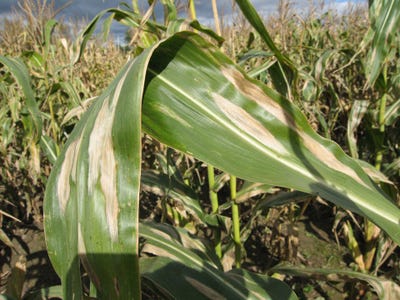June 27, 2022

Northern corn leaf blight (NCLB) is a foliar disease that, if left untreated, can cause significant yield loss. Yield losses are most severe when NCLB infects corn plants early and reaches the upper leaves by the beginning of ear fill.

While it can be found wherever corn is grown, three main factors lead to NCLB infection: air temperature, high humidity and leaf wetness hours. Early NCLB symptoms appear as long, narrow, tan lesions that form parallel to leaf margins. The cigar-shaped lesions produce olive-green or black fungal spores when humidity is high, which can give the lesions a dark or dirty appearance.
Disease spores are spread locally by rain splash, where primary infections are produced. Secondary spread occurs from plant-to-plant and field-to-field as spores are carried long distances by the wind. It has also spread in recent years due to major weather events, especially hurricanes, which carry the organism from southern climates to North America.
Infections generally begin on lower leaves and then progress up the plant. However, in severe NCLB outbreak years (that have high spore levels), infections may begin in the upper plant canopy.
“We really want to protect the ear leaf and the upper third of our crop canopy in order to maximize our crop health,” said Adam Owens, Pioneer Field Agronomist.
Yield loss from NCLB occurs when lesions reduce the leaf area of the plant that carries out photosynthesis. The more lesions on a plant and the earlier in the season the lesions develop, the greater the loss of photosynthetic area and the greater the potential yield loss.
Effective NCLB management practices include selecting resistant hybrids, reducing corn residue in the field, timely planting, and applying foliar fungicides.
Decisions to use a fungicide should be based on the disease risk factors of the field, including hybrid susceptibility, cropping sequence, tillage system, location, disease history, yield potential, the price of corn, and expected weather during reproductive development.
Source: Corteva Agriscience, which is solely responsible for the information provided and is wholly owned by the source. Informa Business Media and all its subsidiaries are not responsible for any of the content contained in this information asset.
You May Also Like




